Items tagged with 'Albany Institute'
Heavy Metal: Cast Iron Stoves from the Capital Region at the Albany Institute

A peek at some of the stoves in the institute's collection from a bunch of years ago when we got a behind-the-scenes tour.
As you'd expect, the collection of the Albany Institute of History and Art has its fair share of art.
But it also has all sorts of other items -- clothing, furniture, documents, various local objects, even stoves. Yep, stoves.
Well, they're not just any stoves. They're intricately-designed and decorated cast iron stoves from the time when Albany and Troy were manufacturing centers for the hot items. And the institute is putting a bunch of them on display.
The exhibit Heavy Metal: Cast Iron Stoves from the Capital Region opens this Saturday. Blurbage:
During the nineteenth century, Albany and Troy, New York, manufacturers were considered to be among the largest producers of cast-iron stoves in the world. Stoves made in these cities were renowned for their fine-quality castings and innovations in technology and design. The strategic location of Albany and Troy, located nine miles apart on opposite banks of the Hudson River, afforded easy and inexpensive transportation of raw materials to the foundries, and finished stoves to worldwide markets.
Cast-iron stove making reached its highest artistic achievement and technological advancement between 1840 and 1870. Flask casting and the advent of the cupola furnace permitted more elaborate designs and finer-quality castings. Stove designers borrowed freely from architectural and cabinetmakers' design books, a process that resulted in the use of Greek, Roman, Egyptian and Rococo revival motifs, patriotic symbols, and lavish floral designs, all reflecting current taste and sentiment. Stoves were given romantic names like "Venetian Parlor," "Gothic Parlor," and "The Temple" to enhance their allure and help the buyer identify them when ordering from a catalogue.
The exhibit will be on display until next August. And the Albany Institute's Tammis Groft will be giving a talk about the exhibit February 24.
Livestock, vegetables, farm equipment, and an object of unceasing admiration
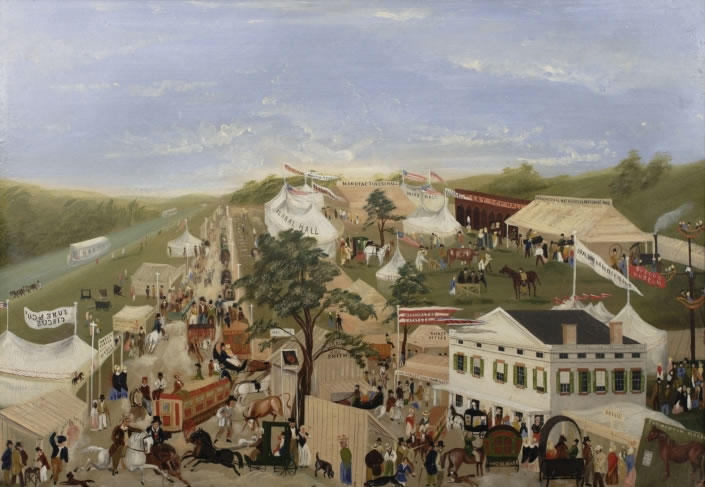
We charmed by this painting of the New York Agricultural Fair that was held in what's now Menands in 1850. It's attributed to John Wilson* and it's part of the collection of the Albany Institute. A clip from the description in the museum's online catalog (link added):
Held just north of Albany, the 1850 Tenth Annual Fair and Exhibition of the New York State Agricultural Society was the second hosted in the capital city. It opened for spectators on September 3rd and ran through September 6th. According to the Society's report*, "never was the attendance so great." This animated work captures the excitement of the fair and the throngs of people who attended the four-day event to see livestock, displays of fruits and vegetables, machinery, and farm equipment. The displays of flowers received special notice in the Society's report: "Floral Hall, in which every form of beauty was combined, under the direction of Dr. Herman Wendell, of Albany, was the object of unceasing admiration." Indeed, Floral Hall appears as the largest and most prominent tent in Wilson's painting.
In addition to agricultural displays, visitors had two circuses to enjoy, the Spalding & Rogers Circus and the June & Co. circus, also carnival sideshows and amusement rides. (A four-gondola ride similar to the later Ferris Wheel can be seen at the far right of the painting.)
If you head over to the Friends of Albany History, there's a walk through some of the history of the history of this fair and the fairgrounds and how the modern Altamont Fair grew out of an animal fair on the parade grounds of what's now Washington Park in Albany.
* John Wilson was also painted the 1848 watercolor "View of State Street, Albany" (also in the Albany Institute collection), which you might have seen before.
Animals in art, pets in America at the Albany Institute
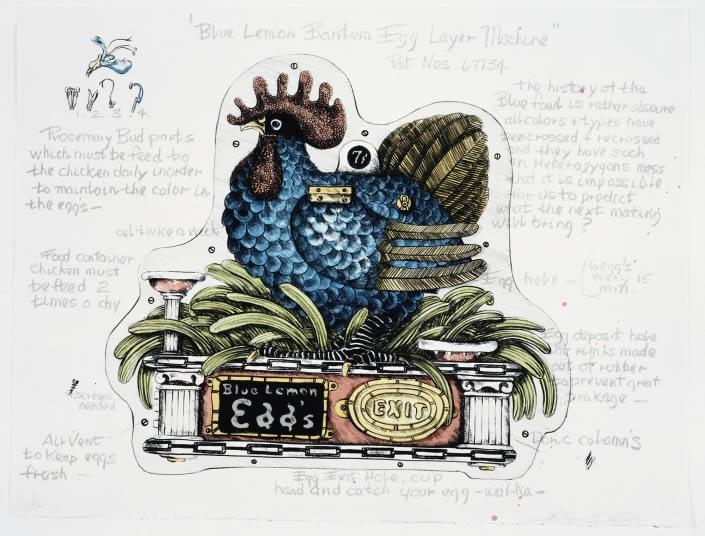
The Albany Institute currently has two exhibits with animal themes -- A Menagerie of Whimsey: The Art of William B. Schade and Birds & Beasts: The Scary, Magical, and Adorable Animals of the Albany Institute -- and to go along with them, it has a few upcoming animal-themed events:
September 7: History on Tap: Animals in Art
"Did you know Albany born illustrator Dorothy Lathrop won the inaugural Caldecott Medal in 1938? And that the owl has been a symbol of wisdom since ancient times? For this special tour we will be learning all about the animals in our collection and their fascinating stories! Enjoy a drink with the group at a local bar following the tour (21+)." Admission is $12 and registration's required, see the link for details. Friday, September 7 at 6 pm
September 30: Pets in America: The History of Our Four-Footed Family Members
A talk by Katherine Grier, a professor of history at the University of Delaware and author of Pets in America: A History. "Pet keeping occurs all over the world, in large and small societies, and has been practiced throughout history. European colonists brought animals to the New World as pets and soon made some local wild animals into pets. By the 1820s, pet keeping was regarded as an important part of happy family life and a way for children to learn "habits of kindness" to everyone. Letters, photographs, print media and artifacts all tell the story of the evolving American love affair with pets, including its growing importance to children. Today, over 65 percent of American households (about 85 million families) include pets." Free with museum admission, though note that seating for the talk is is first come, first serve. Sunday, September 30 at 2 pm
Retyping Ironweed at the Albany Institute
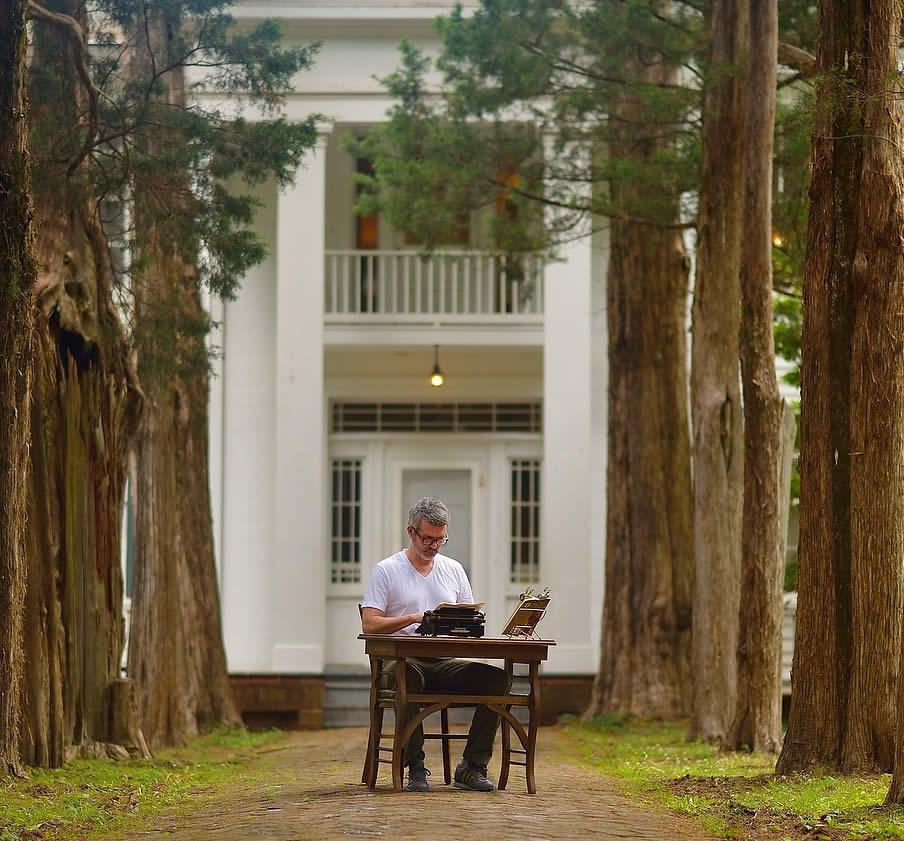
Youd retyping William Faulkner's The Sound and the Fury at the author's home in Oxford, Mississippi in 2014. / photo: Robert Jordan, University of Mississippi.
Gotta admit we don't know what to think about this, but if you see a guy typing on old-school typewriter outside the Albany Institute next week...
Performance artist Tim Youd will be at the museum Sunday and Tuesday-Saturday retyping William Kennedy's Ironweed as part of an ongoing project to retype famous novels in locations that are somehow significant to the author's work. Press release blurbage:
Employing the same make and model typewriter used by the author, Youd types each novel on a single sheet of paper, which is backed by an additional support sheet. The artist loads the two-ply paper through the typewriter repeatedly, until the entire novel has been retyped. As the typing progresses, the top sheet becomes saturated with ink and perforated from overuse, while the sheet underneath becomes embossed from indentation. Upon completion, the two pages are separated and mounted side by side as a framed diptych, recalling two pages of an open book with the words obscured. The diptych remains as a relic of the performance that embodies the novel, even though it is completely illegible.
According to the artist, "The genesis of the project came from my recognition that on a formal level, when you are looking at two pages of a book, you are looking at two rectangles of black text inside two larger rectangles of the white pages. I had the palpable desire to crush the words of the entire book into this formal language." It also becomes an investigation of memory, attention, and the act of reading. The artist explains, "We don't remember every word no matter how prodigious our memory--rather, we are left with some kind of layered impression."
Youd will be in the atrium of the Albany Institute, and if the weather is nice, outside on the museum's Washington Ave lawn. There's also a Thursday evening reception with samples of Albany Distilling Company's "Ironweed" products. See that link above for the schedule.
See also this Paul Grondahl article about the upcoming performance, including William Kennedy's quote at the end.
Youd is currently working through a Hudson Valley phase. He's at Olana this week, where he's retyping Light Years by James Salter.
"The Normanskill" by Edward B. Gay

If you head over to the museum's online collection you can zoom in on the painting.
Art break? Yes, let's engage in an art break.
The painting above is "The Normanskill" by the landscape painter Edward B. Gay. It's in the collection of the Albany Institute of History and Art, and it's also currently on display in the museum. It dates to around 1865.
Gay was born in Ireland in 1837. His family emigrated to the United States in 1848 because of political unrest related to Irish nationalism (there was also famine at the time). The Gays found their way to Albany and settled. By the time they got here they were not doing well financially and the children were put to work to earn money.
Edward Gay, who was about 11 years old, had jobs at a bowling alley and as a page in the state Assembly. He also, somewhat improbably for someone his age, ended up with a job mixing drinks. And even more improbably, it was at that job that his artistic talent was discovered.
Hudson Valley Hops 2018

Workers at the George I. Amsdell Brewery in Albany sometime around 1910. / via Albany Institute of History & Art, Main photo Collection
The Hudson Valley Hops beer event returns to the Albany Institute May 19. Event blurbage:
Enjoy a regional craft beer tasting as well as an exhibition of local brewing history and a special program about brewing history in Troy.
Hudson Valley Hops 2018 will feature a one-time blind taste test featuring session beers from craft brewers in the Hudson Valley. Hosted by Steve Barnes of Times Union Table Hopping, with Jess Briganti, Weekday AM Weather Anchor for News10 ABC; Spectrum News/AlbanyArchives' Matt Malette; and Deanna Fox, local food writer as judges.
Hear from David Mulholland, whose family helped shape brewing history in Troy as Stoll's brewing, during a program called Brewing Beer in a Melting Pot. You'll also have the chance to help choose the 2018 People's Choice, and we'll have food from BMT Hospitality.
Eleven breweries from around the region are lined up to participate.
Hudson Valley Hops is Saturday, May 19 from 4-7 pm. Tickets are $35 ahead / $40 at the door.
Flowers from the Netherlands, then

Decorative arts break: The earthenware tiles above are from the collection of the Albany Institute -- they date to around 1625 and they were made in the Netherlands. We love the illustrations of the flowers and the blue-patterned background. If you head over to the Albany Institute's online collections you can zoom in and see all the little details.
These pieces are tin-glazed, which gives them that characteristic shiny white background. The style was hugely popular in the Netherlands around this time -- the country made huge numbers of them. And a specific version of this technique, famously using blue patterns on white, became associated with the Dutch city of Delft. The style of the tiles above is called faience.
These tiles were a gift to the museum from Mabel Brady Garvan. She and her husband -- Francis Patrick Garvan, a prominent attorney and chemical industry official during the first quarter of the 20th century -- were collectors of all sorts of decorative objects. Many of those pieces are in the The Mabel Brady Garvan Collection at Yale.
The Albany Institute has all sorts of pottery and earthenware in its collection, many examples of which are posted in the museum's online collection if you'd like to gawk.
Well-Dressed at the Albany Institute
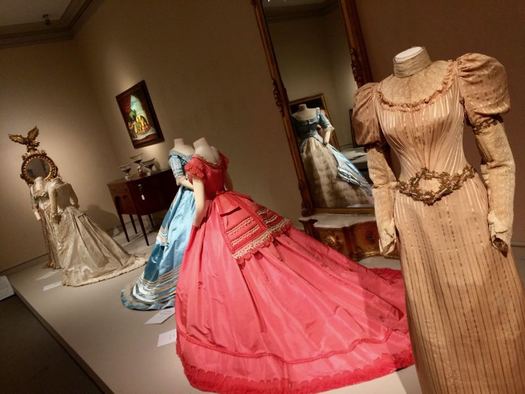
Pretty much everyone has clothing tucked into the back of their closets that they haven't worn in a long time. And the Albany Institute of History and Art -- which has many, many closets -- is no different.
Well, except for the fact that pieces hanging in the back of its closets were created by some of the foremost fashion houses of the 19th century.
"They're masterworks," said Diane Shewchuk, the curator of the new Well-Dressed in Victorian Albany exhibit, of the pieces. "We have Thomas Coles and Frederick Churches that are masterworks. This is the equivalent. But these are probably what more people would have seen than a painting in a house. So this is really an exhibition about the best of the best, the same way we show upstairs the Hudson River School."
Albany and Anti-Suffrage at Albany Institute
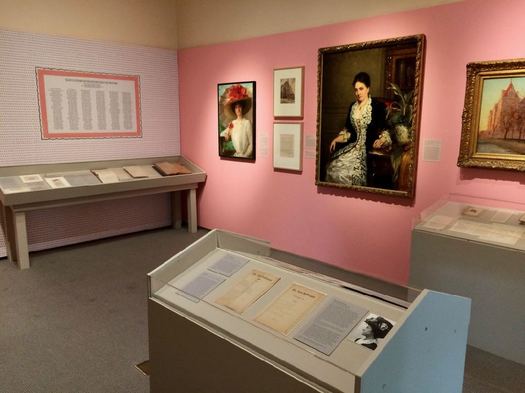
Pink was one of the trademark colors of the anti-suffrage movement.
New York State was a hotbed of the women's suffrage movement. Seneca Falls. Susan B. Anthony. Elizabeth Cady Stanton. It's a story you know.
But New York -- and Albany, specifically -- was also a focal point of the anti-suffrage movement.
A new exhibit at the Albany Institute of History and Art shines a light on this aspect of the story surrounding the push for women's suffrage. Blurbage:
Today it is impossible to imagine a world where women didn't have the right to vote. The years leading up to 1917 were fraught with difficulty both politically and personally for women on both sides of the argument. Not every woman wanted the right to vote. In fact, Albany was considered a stronghold of the anti-suffrage movement. This exhibit tells the story of the women who first met in 1894 before the New York Constitutional Convention convened, organized the Albany branch of the New York State Association Opposed to Woman Suffrage, lobbied to make their views heard in 1915, and lost their fight in 1917.
As the exhibit notes, 8,000 women in the Albany area signed document in 1894 opposing a change to the state constitution that would have opened the way for women to vote. And a listing details the officers of a local anti-suffrage women's group in 1905 -- it's full of prominent names you'll recognize from local history.
The Hudson River School at Albany Institute
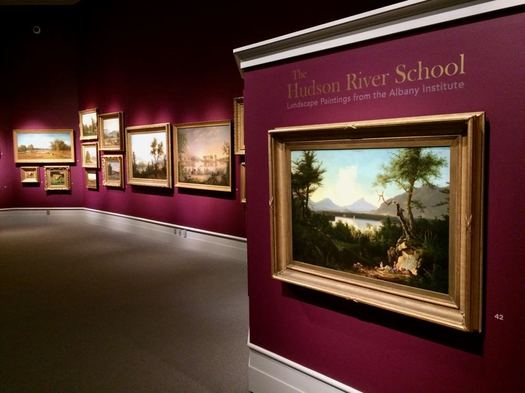
One of the most well-known and popular groups of items in the Albany Institute's collections are its Hudson River School paintings.
And the museum recently put (almost) the entire collection on display.
2017 Artists of the Mohawk-Hudson Region
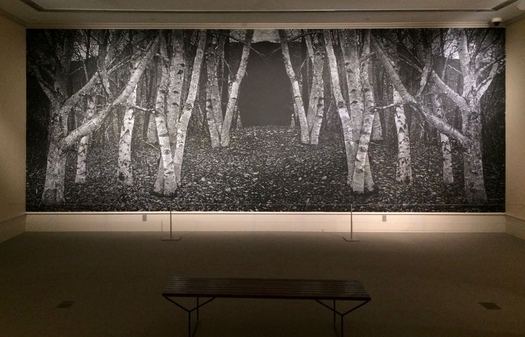
Among the works in this year's exhibition is this chalk mural by Richard Barlow
The 2017 Exhibition by Artists of the Mohawk-Hudson Region opens this weekend at the Albany Institute. The annual exhibit is now in its 81st year and it's said to be the longest running annual juried exhibition in the country. It's open to artists living within 100 miles of Albany and Glens Falls.
The exhibit includes 87 works from 32 artists. They were selected by this year's juror -- Jack Shear, a photographer, curator, and president of the Ellsworth Kelly Foundation -- from a pool of 600 works submitted by 268 artists. The pieces range from paintings to sculptures to mixed-media works.
The annual exhibit rotates among the The Hyde Collection, the University Art Museum at UAlbany, and the Albany Institute. Each year the institutions acquire pieces from the exhibit for their collections. The Albany Institute has put on display some of the works it's acquired over the years at the head of this year's exhibit.
When you stop by for a look, also wander through the institute's adjacent gallery of 19th century sculpture. Shear has directed a temporary re-installation of the pieces there to provide a different perspective on them.
The 2017 Exhibition by Artists of the Mohawk-Hudson Region is on display at the Albany Institute through September 3. There opening ceremony and awards reception was Friday evening. And there's a series of gallery talks with some of the artists throughout the summer. That schedule is below.
What's in the Albany Institute's closets
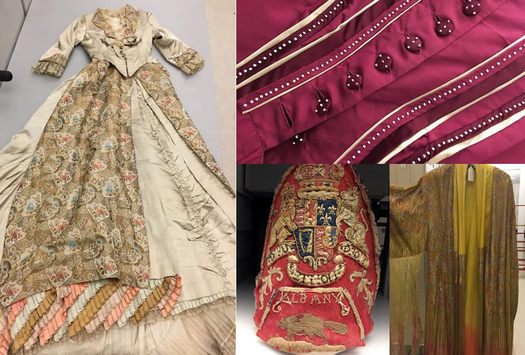
Here's something fun while you're trying to decide if it's finally time to switch your closet over from winter to summer -- a look into the closets at the Albany Institute.
Among its collection of paintings, patents, mummies, and Albany historical artifacts, there are rows of closets filled with clothing made in, or worn in, the Capital Region over the centuries.
The collection ranges from 18th century Paris couture gowns, to 1920s flapper dresses, to 1960s and 70s mod. And there are shoes and accessories, too.
We persuaded curator Diane Shewchuk to let us poke around in the institute's closets this week. Here's some of the fun stuff we found.
Hudson Valley Hops 2017
 The Hudson Valley Hops event is back at the Albany Institute April 8. Tickets are $35 ahead and available online.
The Hudson Valley Hops event is back at the Albany Institute April 8. Tickets are $35 ahead and available online.
The annual event celebrates the history of brewing in the Hudson Valley, and this year has an Erie Canal theme. There will be tastings, a local IPA blind taste test, and special Irish Red Ales from Chatham Brewing and local craft beer pioneer Bill Newman in collaboration with Brown's.
Local brewing artifacts will also be on display.
Here's the list of participating breweries...
Wampum World at the Albany Institute

A portion of deed for land in Rensselaerwyck signed in 1708, from the Albany Institute's collection. The pictographic characters are the signatures of Native Americans.
A new multimedia exhibit called Wampum World opened at the Albany Institute this past weekend. In it artist Renee Ridgway looks at the role wampum played in this area during the 17th century as Native American and Dutch cultures met and interacted, and how some of those threads carry on today:
"Wampum World is about wampum, which is made from shell. Historically, it had manifold functions for Native Americans in various aspects of their societies and is still considered sacred today. In contrast, Dutch settlers, having recognized the value of wampum for Native Americans, used wampum in exchange with European goods in order to procure beaver pelts, as part of the seventeenth century trade triangle 'beaver, wampum, hoes.' Metal coinage was not readily available in the New World, therefore wampum served as currency. Wampum World visually elucidates this historical exchange system and present day usages of wampum from various perspectives."
In Motion: The African-American Migration Experience at The Albany Institute
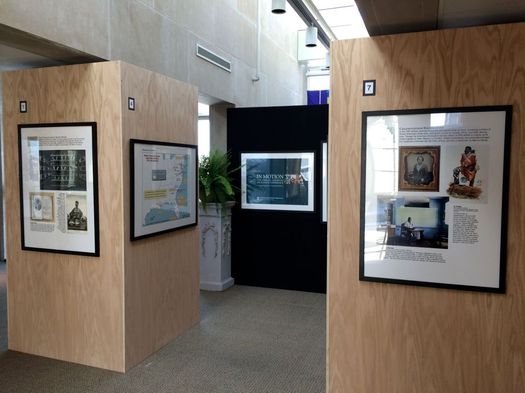
Opening this weekend at the Albany Institute: In Motion: The African-American Migration Experience, a traveling exhibit from the Schomburg Center for Research in Black Culture at The New York Public Library.
From the companion website for the exhibit:
[U]ntil recently, people of African descent have not been counted as part of America's migratory tradition. The transatlantic slave trade has created an enduring image of black men and women as transported commodities, and is usually considered the most defining element in the construction of the African Diaspora, but it is centuries of additional movements that have given shape to the nation we know today. This is the story that has not been told.
In Motion: The African-American Migration Experience presents a new interpretation of African-American history, one that focuses on the self-motivated activities of peoples of African descent to remake themselves and their worlds. Of the thirteen defining migrations that formed and transformed African America, only the transatlantic slave trade and the domestic slave trades were coerced, the eleven others were voluntary movements of resourceful and creative men and women, risk-takers in an exploitative and hostile environment. Their survival skills, efficient networks, and dynamic culture enabled them to thrive and spread, and to be at the very core of the settlement and development of the Americas. Their hopeful journeys changed not only their world and the fabric of the African Diaspora but also the Western Hemisphere.
As you might already know, one of the places changed by these migrations of Americans was the city of Albany. A contingent of people from the South -- mainly Mississippi -- moved to Albany during The Great Migration and settled in the South End. (There's now an annual Mississippi Day festival in Lincoln Park.) And it was from there that a group eventually moved out to the Pine Bush and created a new neighborhood, which is now The Rapp Road Community Historic District.
We got a chance to see the In Motion display at the Albany Institute Friday. It's not big, but there are a lot of interesting bits and is worth a look. It's on the museum's top floor, just keep heading up the main stairs. And it's free -- no admission required.
(Though if you're there, you should also check out the recently-opened Captured Moments exhibit.)
The Albany Institute advertises on AOA.
Captured Moments at the Albany Institute
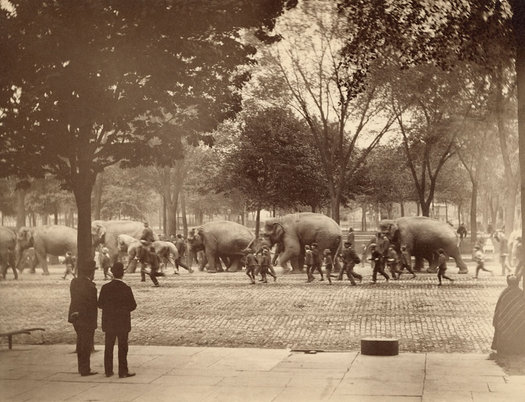
A circus parade in Albany during the 1880s.
The Albany Institute opens a new exhibit this weekend -- Captured Moments: 170 Years of Photography from the Albany Institute -- that includes a sampling from the museum's extensive collection of photographs. It's on display through May 21.
We got a quick tour of the exhibit Friday as curators were still putting the finishing touches on the displays. The photos cover a wide range of topics, from portraits, to historical scenes, to cityscapes, to interiors, to workplaces, to travel photos. There's even an photo a seemingly badass bowling club from Arbor Hill. (Nobody rolls like the The Maples!)
Doug McCombs, the Albany Institute's chief curator, said the museum has tens of thousands of photos -- dating back to the 1840s, near the beginning of the medium -- and they're probably its most popular collection. Captured Moments is intended sampling of sorts.
"It's a way to show the breadth of our collection," he said.
Here are a handful of photos of from the exhibit...
The Capital Region in 50 Objects, online
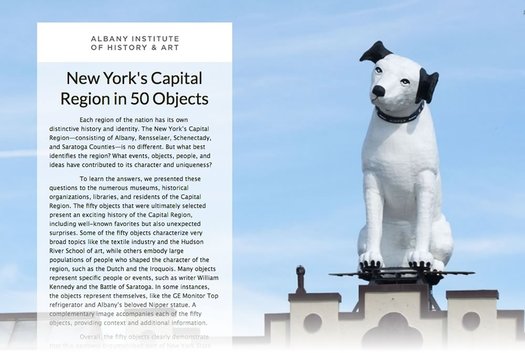
Check it out: The Albany Institute of History and Art has created an online version of the Capital Region in 50 Objects exhibit, which closed this past spring.
The exhibit is pretty much what it sounds like -- a walk through the area's history using 50 objects as markers. But while it includes some of the prominent stories you'd expect -- like the Erie Canal or Battle of Saratoga -- there are also quirkier items such as the perforated toilet paper invented here and the area's tobogganing craze.
The online exhibit includes quick histories and images in an easy-to-navigate format.
The Albany Institute is also publishing a book about the exhibit:
New York's Capital Region in 50 Objects book's stunning photographs and rich descriptive text make this popular exhibition come alive again. The 112-page, full color publication features a two-page spread for each object, which includes color illustrations and informational text.
It'll be available at the museum gift shop in early December for $18.95.
And there's a teachers' resource for the exhibit with 18 lessons.
Earlier on AOA: The Capital Region in 50 objects
Hudson Valley Hops 2016
 The Hudson Valley Hops event will be back at the Albany Institute April 16. Tickets are $35 ahead / $40 at the door.
The Hudson Valley Hops event will be back at the Albany Institute April 16. Tickets are $35 ahead / $40 at the door.
The annual event celebrates the history of brewing in the Hudson Valley. This year's it will be marking the 35th anniversary of Newman's Pale Ale, which was once produced by Bill Newman in (what's now known as) the Warehouse District in Albany and played a key role at the beginning of the craft beer boom. (Newman was recently at Davidson Brothers in Glens Falls for the brewing of a new batch of the beer.)
Additional blurbage:
Enjoy a one-time blind taste testing featuring 12 to 15 pale ales from craft brewers up and down the Hudson Valley, from Lake George to Yonkers. Hosted by Steve Barnes of the Times Union's Table Hopping with celebrity judges including Ric Orlando.
The event also includes food from New World, a commemorative glass, and an exhibition of local brewing history.
AIHA advertises on AOA.
Now open: Crisan Cafe at the Albany Institute

Crisan Cafe at the Albany Institute of History and Art
The cafe in the storefront of the popular Crisan bakery on Lark Street closed a little more than a year ago.
But now it's back in a new form. And it's joined by New World Catering. And art.
"Old Albany through the Eyes of William Kennedy's Fictional Characters" at Albany Institute

This circa 1930 photo shows 67 Dove Street in Albany -- the place where the Legs Diamond was famously killed in 1931 after he was acquitted in a kidnapping trial in Troy. (The building's still there today.) William Kennedy wrote a novel about the gangster called Legs. / photo from the Morris Gerber Collection
The Albany Institute is hosting a talk by William Kennedy about the intersections of the characters in his books and real Albany places on March 6. Blurbage:
Pulitzer Prize-winning novelist William Kennedy, who uses his hometown of Albany, New York, as the inspiration for his work, will present a slide show of historic Albany scenes that are featured prominently in the novels. He will discuss the ways in which his characters inhabit Albany's buildings and streets.
The event is at 2 pm on Sunday, March 6. It's free with museum admission. (We suspect this will be popular, so showing up a bit early to grab a seat is probably a good idea.)
AIHA advertises on AOA.
William Kennedy + Michael Oatman at Albany Institute

William Kennedy and Michael Oatman will be at the Albany Institute this Sunday for a conversation about creativity. Blurbage:
Kennedy, a Pulitzer Prize-winning author, and Oatman, an artist, curator, and professor at Rensselaer Polytechnic Institute, are highly regarded for their creativity and their contributions to the Capital Region's rich art and literary environment. Kennedy and Oatman will talk about the creative process and how they have used the Capital Region as inspiration and basis for their work.
The conversation is connected to the exhibition
The event is Sunday, October 18 at 2 pm. It's free with museum admission -- stop at the front desk to get a ticket.
The Albany Institute advertises on AOA.
The Capital Region in 50 objects
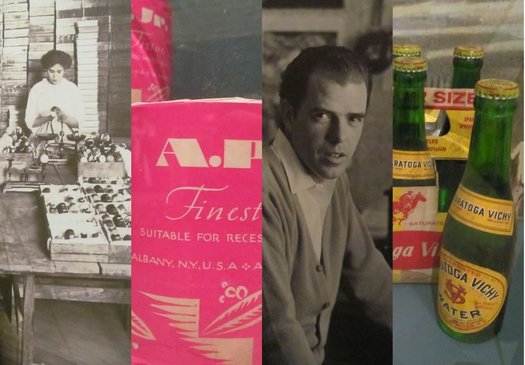
What do Nipper, a video game, a steel butterfly and a chamber pot have in common? They're all part of a collection of 50 objects that help tell the story of this area.
The Capital Region in 50 Objects opens on Friday at the Albany Institute of History and Art. The exhibit is inspired by the British Museum's History of the World in 100 Objects and the New York Times' History of New York in 50 objects. The exhibit opens on Friday with a reception at 5:30 pm, and will remain open through April.
Chief curator Doug McCombs says the selection process took about three years. First they surveyed the region's museums and cultural institutions to see what was in the collections that might be appropriate. Next they took public polls through the Times Union to help determine which topics people wanted to see addressed. Finally, they worked with an advisory committee to select 50 subjects and items that would represent those subjects. Among the topics highlighted: the Empire State Plaza, Albany Ale, industry, The Anti-Rent Wars, the Underground Railroad, literature, food, entertainment and broadcasting.
Each object is displayed with a background image that helps to tell its story -- and the images are just as interesting, in some cases even more interesting -- than the objects themselves.
Here's a sneak peek at what you'll see.
Seeing Double at the Albany Institute

Opening this weekend at the Albany Institute of History and Art: Seeing Double: The Anaglyphs of Eric Egas.
Anaglyph? They're stereoscopic images that appear to be 3D when viewed with through special glasses.
Exhibit blurbage:
In this experiential exhibition, Egas engulfs viewers in situational modalities through the selection and placement of anaglyphs that explore human relationships with nature, the meaning of the absurd, human aggression, and aesthetic impulses. Thirty-five prints, ranging in size of about four square feet, show the range of Egas' career experimenting with the medium. Visitors will explore the exhibition with anaglyph viewers which will allow them to experience the depth and contrast of the photographs.
And, yep, 3D glasses will be provided.
The exhibit opens this Saturday (August 15) and runs through October 25.
Egas, who spends part of the year in Greenville, will be at the Albany Institute September 3 for a talk about his work. And because that's a Thursday, admission to event is free.
The Making of the Hudson River School -- online

"A View of the Great Cohoes Falls on the Mohawk River," Thomas Pownall (1722-1805), engraved by Paul Sandby (1725-1809), etching on laid paper, c. 1761-1768 - Albany Institute of History and Art, Bequest of Ledyard Cogswell, Jr.
The Albany Institute of History and Art has put together an online version of its The Making of the Hudson River School exhibit, which ran in 2013. Blurbage:
[T]his exhibition reveals that much more went into the making of the Hudson River School, such as the influence of European traditions and cultural movements, as well as America's natural environment and commercial spirit. The Hudson River School also emerged alongside the new medium of photography, the new science of geology, and new technologies that transformed travel and inaugurated an industrial revolution. The Hudson River School ultimately helped shape an American identity.
The online exhibit is nicely designed, taking you a series of themes and developments that set the stage for, and then exemplified, the Hudson River School. And it's packed with works of art -- many of them depicting local scenes -- that you can click on to get better view.
One work that caught our eye today in the "Topographical Tradition" section was this above drawing of the Cohoes Falls by a British official Thomas Pownall in the late 1700s. From the description that accompanies the work:
Pownall visited the falls twice, but it was during his second visit, when the river was high, that he encountered its sensational splendor and made his sketch. He recounted "I went a second Time to view these Falls; they were then a most tremendous Object. The Torrent, which came over, filled the whole Space from Side to Side; before it reached the Edge of the Fall it had acquired a Velocity which the Eye could scarce follow; and although at the Fall the Stream tumbled in one great Cataract: yet it did not appear like a Sheet of Water; it was a tumultuous Conglomeration of Waves foaming, and at Intervals bursting into Clouds of Vapour, which fly off in rolling Eddies like the Smoak of great Guns."
The Albany Institute has been steadily expanding its online collections, which are full of maps, drawings, and objects related to Albany-area history and beyond.
The Albany Institute advertises on AOA.
Hudson Valley Hops 2015
 The Hudson Valley Hops event returns to the Albany Institute April 18.
The Hudson Valley Hops event returns to the Albany Institute April 18.
The event will again include regional craft beer and cider tastings, and an opportunity to check out the brewing and distilling items in the museum's collections. Also: Chatham Brewing will be creating an "Albany Institute Ale" exclusively for the event. Blurbage:
While Chatham Brewing has created custom beers for bars and restaurants, this is the first time they are making one for an event. The theme of Hudson Valley Hops inspired them to try to get as close as they can to an all 100% New York State beer. According to [Tom] Crowell, the beer can be described as "a standard ESB [Extra Special/Strong Bitter]" with a nutty sweetness. Albany Institute Ale was made with New York State 2-row pale malt as a base; some Light and Dark Crystal to show off a copper hue and give a slight caramel flavor; and local Columbia County grown hops, including Cascade from Germantown Hop Farm and Nugget from Spring Hill Farm to add a subtle bitterness. Although it is called an extra special bitter, compared to an IPA, this will not be a bitter beer.
There will also be a handful of guest speakers throughout the evening talking about food, brewing, and the history of brewing in this area.
Hudson Valley Hops is Saturday, April 18 from 4-7 pm. Tickets are $35 ahead / $40 at the door.
The Albany Institute advertises on AOA.
"Time for Beverwyck," Beverwyck Breweries, INC. / Albany Institute of History & Art
One Plastic Bag at Albany Institute
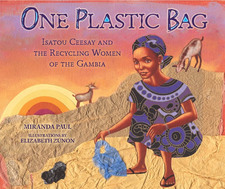 The Albany Institute is hosting an event this Saturday with Isatou Ceesay, a Gambian woman who created a community-based recycling program. Her story is the subject of One Plastic Bag, a new picture book by author Miranda Paul and Albany-based illustrator Elizabeth Zunon. Paul and Zunon will both be at the event.
The Albany Institute is hosting an event this Saturday with Isatou Ceesay, a Gambian woman who created a community-based recycling program. Her story is the subject of One Plastic Bag, a new picture book by author Miranda Paul and Albany-based illustrator Elizabeth Zunon. Paul and Zunon will both be at the event.
Here's a Guardian feature about the program Ceesay and group of women started in Gambia. It's a remarkable story -- they built a recycling program in place where there wasn't even municipal waste collection, and did it in a way that helped provide jobs and income for people.
The Albany Institute event will include a reading and talk, as well as a project for kids to create their own recycled art project -- there are workshops at noon and 3 pm. It's free with museum admission.
Earlier on AOA:
+ Holiday gifts: Elizabeth Zunon
+ So, how do you create a giant clog sculpture?
"Triple Play!" at the Albany Institute
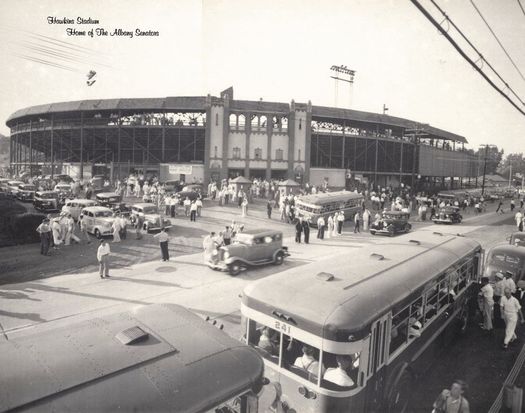
Hawkins Stadium in Menands was the home of the Albany Senators.
Despite out evidence outside to the contrary, it won't be long until spring arrives. (It's true. We checked a calendar.) And along with spring will come baseball.
The Albany Institute is getting an early start on the season (both of them) with a new exhibit called "Triple Play!" It includes a bunch of historical baseball photos, memorabilia, and items from the major leagues and the Capital Region's own rich baseball history.
The exhibit opens this Friday night, February 6. We got a look earlier this week. Here's a quick trip around the bases...
Warmth with flair

Historical object gawking: We came across this photo of a 19th century stove in the Albany Institute collection. It was made by a Troy company -- Johnson, Geer & Cox -- based on a design by Troy resident Ezra Ripley, probably around 1844. At the time it was advertised as as a "cheap and beautiful article for offices and parlors."
It's a gorgeous object -- as a stove, or even as art. The Google Cultural Institute viewer allows some very close closeups of the details.
From the Albany Institute description:
Cast-iron stovemaking reached its highest level of artistic achievement and technological advances between 1840 and 1870. Stove designers borrowed from architectural and cabinetmakers's design books, bringing Greek, Roman, Gothic, Egyptian, and Rococo revival motifs, along with patriotic symbols and lavish floral designs, in stoves. The technical design of this column parlor stove included a small rectangular firebox to which were connected four vertical flues (or columns). All were connected at the top by a horizontal pipe or second chamber. The increased surface area and greater air circulation of this design enhanced the amount of radiated heat.
Troy and Albany were prominent centers of the stovemaking industry during the 19th century, with hundreds of stove manufacturers trying to stake out a spot in the marketplace over the century.
Sometimes it's easy to romanticize the past and look past its negatives. Sure, there were gorgeous parlor stoves -- but they were often manufactured by people working in terrible conditions. And there are so many things -- in terms of people's rights, technology, and so on -- that are so much better now compared to then (even if there's still room to improve). But objects like this stove were made with a certain flair.
photo: "Four-Column Parlor Stove" via Albany Institute collection
Covered in history

The objects of history can take many forms: artifacts, paintings, sculptures, devices, even blankets.
Yep, blankets.
The Albany Institute opens a new exhibit these weekend that highlights the museum's collection of textiles -- specifically quilts, coverlets, and bed hangings -- from the 18th, 19th, and 20th centuries. And while that might sounds a bit... sedate? ... we were struck during an early peek at the exhibit this week how much the quilts served as a media to communicate ideas, desires, and identity. They were like the Pinterest boards of the 1700s.
Here are a handful of photos from the exhibit, along with a quick Q&A with the institute's chief curator about quilts as social media, the evolution of the bedroom, and why textiles need their rest.
The Great Abraham Lincoln Pocket Watch Conspiracy at the Albany Institute
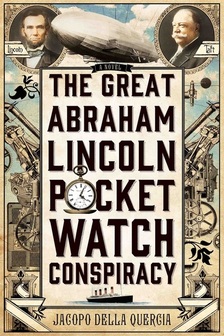 This could bizarre and fun: The author of The Great Abraham Lincoln Pocket Watch Conspiracy will be at the Albany Institute for a talk October 5.
This could bizarre and fun: The author of The Great Abraham Lincoln Pocket Watch Conspiracy will be at the Albany Institute for a talk October 5.
What is this conspiracy, you ask. Let us turn our attention to the blurbage:
Join Albany historian and writer Giacomo Calabria (pen name, Jacopo della Quercia) for a lively talk about his recently published historical novel that is part sci-fi, part action adventure, and part comedy embedded in a narrative based on meticulous research. The result is an outlandish secret history that aligns perfectly with national as well as the city of Albany historical record.
Calabria is an educator and history writer whose work has been featured on the comedy website Cracked.com, BBC America, CNN Money, and the Huffington Post.
Here's an A.V. Club review of the book. And article in Slate from earlier this year by Calabria: "Abraham Lincoln's Steampunk Presidency."
The talk at the Albany Institute is at 2 pm on Sunday, October 5. It's free with museum admission.
The Albany Institute advertises on AOA.
The history of Albany as seen through beer-colored lenses

Upper Hudson Valley Beer and co-author Craig Gravina
There are many ways to look at the long history of Albany and the surrounding region: politically, economically, architecturally, and so on. Craig Gravina and Alan McLeod have chosen to do so through beer-colored lenses.
The two beer scholars -- you might remember them from the Albany Ale Project -- have teamed up to write Upper Hudson Valley Beer, a book about the rich history of brewing in this region and its resurgence over the last few decades. There's a launch party for the book -- with a beer tasting -- at the Albany Institute on September 11.
We bounced a few questions to Gravina this week about the role of beer in Albany's history, the state of the region's beer scene today, and where it might be headed.
Hudson Valley Hops 2014

A tray from the old Beverwyck Brewery in Albany. It once stood on Ferry Street, not far from where the Central Warehouse stands today.
Could be fun/interesting: The Hudson Valley Hops event returns to the Albany Institute April 12. Blurbage:
This event is a celebration of the strong history of brewing in Albany and today's craft beer industry. Guests can sample the finest local craft beers, hear talks by beer historians and brewery experts, enjoy tasty food, and take home a commemorative glass. There will also be a special exhibition with artifacts that tell the history of brewing in Albany and the capital region. Historic photographs, advertisements, and packaging from local brewers will be on view for this event. ...
Participating breweries include: Adirondack Brewery, Brewery Ommegang, Brown's Brewing Co., Chatham Brewing, C.H. Evans Brewing, Druthers, and Olde Saratoga Brewing Co.
Guest speakers include: Craig Gravina and Alan McLeod from the Albany Ale Project; Dietrich Gehring from Indian Ladder Farms; Roger Savoy from Homebrew Emporium; and Sam Filler from the Craft Beer Initiative at Empire State Development.
Albany has a long, interesting brewing history. So there's definitely a lot hear about. And, you know, there will also be beer.
The event is from 4-7 pm at the museum on April 12. Tickets are $30 each.
Earlier on AOA: Resurrecting a beer, and part of Albany's history
The Albany Institute advertises on AOA.
image: "Beverwyck Brewing Company Serving Tray" from the collection of the Albany Institute of History and Art
The Albany Institute, Googled
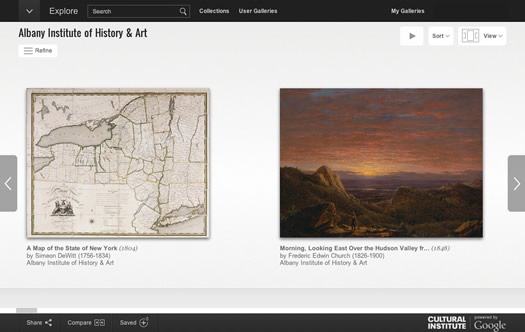
A screengrab from the Albany Institute's collection on Google Art Project.
Check it out: The Albany Institute of History and Art has been added to Google's Art Project, an online gallery of works from museums around the world.
The Google project, started in 2011, now includes 53 works from the institute, ranging from old images of Albany to the Hudson River School paintings to photos of objects. The interface for browsing the images is nice -- and the works are available is very high resolution. An example: check out this panorama of the Albany waterfront from around the beginning of the 20th century. You can zoom in to see details very clearly.
Google Art Project currently has collections from 314 museums posted online. Of that group, 92 museums are also available in "museum view" -- it's like StreetView, but inside the museum. Example: The Art Institute of Chicago.
The Albany Institute will eventually be joining that group -- the Google camera was there today.
It's good to know that when Google's army of robots eventually over the world, the art might be saved.
Earlier on AOA: Virtually browsing the Albany Institute's collections
The Albany Institute advertises on AOA.
screengrab from Google Art Project
Looking up State Street, almost a century ago

An old view that was once new.
The Albany Institute shared this photo on Twitter this week -- it's a look up State Street in Albany in 1917, from the Delaware & Hudson Railroad Building. (The institute has a bunch of photos from its collection online.)
We always love to gawk at old photos and this one's no different. Three things about it:
+ Construction of the D&H building (now the SUNY central administration building) spanned from 1914 to 1915. So, in some sense, this view had only existed for about two years when the photo was taken. Because before that, there wasn't a tower from which to take the photo.
+ Look down toward the bottom of the photo, on the left side, near where State Street meets Broadway. See that awning and the restaurant sign? That appears to be right where the awning for Jack's is today. Jack's didn't move to that spot until 1937, but it looks like there was a restaurant there even at the time of this photo.
+ The streetcar tracks are visible on the roads in the photo, and there's a horse-drawn cart on Broadway. But also look closely along the sides of State Street -- yep, cars. (The Model T was about a decade old at this point.) And they're parking along State Street much in the same way they still are almost a century later.
There's a large-format, uncropped version of the photo after the jump.
A look at the new mummy exhibit at the Albany Institute of History and Art
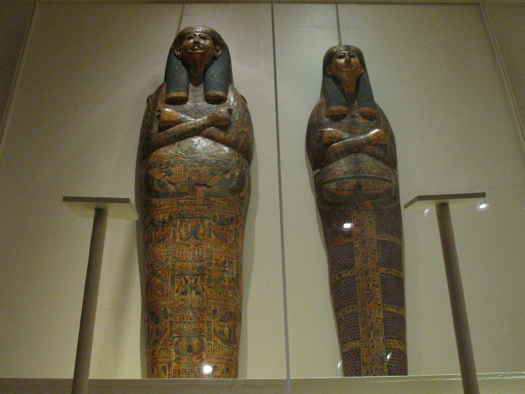
You live your life as a priest or sculptor. You die. You're preserved, sent off into the afterlife. And there you rest for 3,000 or 2,300 years. Then a decidedly unrestful period. Your effects are split up. You're partially unwrapped to make sure you're not "squishy." You're sold for maybe $100. A steamboat ride to the other side of the planet. Fanfare. Hubbub. Outright mania. Gender confusion. Gawkers. So many school children. An x-ray. Another x-ray. Is that the beginning of understanding? Finally?
To put it another way: the afterlife is complicated.
It's one of themes that emerges from the Albany Institute of History and Art's new exhibit, "The Mystery of the Albany Mummies," which opens this Saturday.
Here's a quick look from a preview Thursday.
Virtually browsing the Albany Institute's collections

"Beverwyck Brewing Company Serving Tray" from the collection of the Albany Institute of History and Art.
The Albany Institute of History and Art has been quietly building an online database of its collections. And this week it publicly announced the catalog is there for the browsing.
The online collections database ranges from paintings to historical objects to posters to maps.
Here are a handful of items that caught our eye while browsing...
Currier and Ives exhibit at Albany Institute
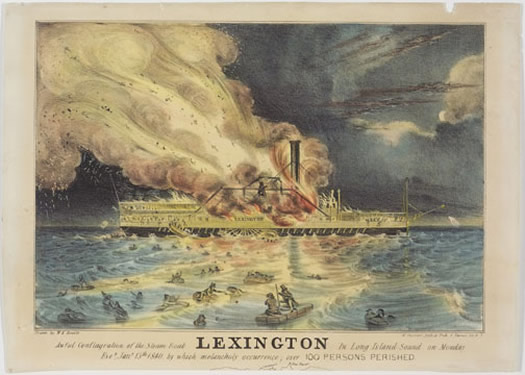
"Awful Conflagration of the Steam Boat Lexington," a lithograph printed by Nathaniel Currier. The Lexington was a luxury steam ship that caught fire and sunk in 1840.
Opening this Saturday (February 9) at the Albany Institute of History and Art: The Legacy of Currier & Ives, an exhibit that includes 64 prints from the famous 19th century printing and publishing firm. Blurbage:
The exhibition, organized around five themes of Identity, Progress, Home, Success, and Artist, introduces the visitor to the firm of Currier & Ives and illustrates, through interpretive and educational materials, how their imagery became ingrained in the national consciousness. During the seventy-two years that Currier & Ives operated (1834-1907) the firm produced more than 8,000 lithographs. Their colorful prints, which hung in homes and public buildings across America, gave testimony to the events and ideas that shaped national history, its progress, and art. Currier and Ives worked with several prominent artists like Eastman Johnson, Arthur Fitzwilliam Tait, and George Henry Durrie, whose designs are represented in the exhibition along with others.
The story behind the firm Currier and Ives is interesting -- it specialized in identifying images that would be popular and then producing them inexpensively. We bet Nathaniel Currier and James Merritt Ives would have been all over the web if they were operating today (CurrierIvesFeed?).
The Albany Institute exhibit runs through June 15. It could make a pretty good double bill with the also-currently-open Making of the Hudson River School exhibit.
The Albany Institute advertises on AOA.
image: "Awful Conflagration of the Steam Boat Lexington," from the Michele and Donald D'Amour Museum of Fine Arts, Springfield, Massachusetts
LEGO Challenge at Albany Institute 2012
 The Albany Institute's LEGO Challenge is back this weekend. Blurbage:
The Albany Institute's LEGO Challenge is back this weekend. Blurbage:
Bring friends, family, and colleagues to work together to create beautiful Lego® structures. This year's theme is "On the River." Whether you're creating a boat, a bridge, a house with a water view, or even an underwater creature, let your imagination run wild! Basic Building blocks will be supplied, however, contestants may bring their own.
Last year's event was a lot of fun, and included some really good designs.
The building sessions are Saturday, Sunday, and Monday (Columbus Day). Registration is $20 per team -- teams can include up to four people, of any age. Space is limited, so the institute recommends pre-registeration.
And, of course, if you don't want to compete, you can just go to check out the designs as part of a visit to the museum.
American Impressionism at the Albany Institute

"In Voorhees’s Garden" by Matilda Browne.
A new exhibit at the Albany Institute of History and Art -- American Impressions: Paintings from the Florence Griswold Museum -- is now open, and there's a reception today (Thursday) from 5-8 pm. From the blurbage:
It is both history and art. The genre is from the turn of the century, complete with all the Yankee charm of New England. And the art is genuinely American, derived from the classic impressionists of Europe and enhanced with authentic Yankee heritage. You might notice the artists' deft use of shadows to accent shapes and dimension, or you might be in awe of the gifted brush techniques, or you might be amazed at the striking use of color -- but nobody has to know any of that to just plain love these beautiful stories told in images.
The exhibit includes 50 paintings from American Impressionists.
The works are on loan from the Florence Griswold Museum in Olde Lyme, Connecticut -- the town was the site of one of art colonies in which American Impressionism simmered around the turn of the 20th century. The Albany Institute and the Griswold Museum have worked out a trade of sorts -- the institute sent the Griswold an exhibit of Hudson Valley art earlier this year, and the Impressionists exhibit is the Grisdwold's side of the trade. It will be on display until January 6.
William Kennedy: The author will be at the Albany Institute Sunday talking about how "how Albany has changed during his lifetime, including downtown, Capitol Hill, Center Square, the advent of the South Mall, the eradication of the Gut, the changes wrought after the decline of the Dan O'Connell / Erastus Corning machine, the leadership of Mayors Tom Whelan and Jerry Jennings, and the role of Nelson Rockefeller in these changes." The talk is at 2 pm. It's $10 / $8 students.
LEGO challenge at Albany Institute
 This looks fun: the Albany Institute for History and Art is holding an Albany architecture LEGO challenge November 25-27. From the blurbage:
This looks fun: the Albany Institute for History and Art is holding an Albany architecture LEGO challenge November 25-27. From the blurbage:
Take part in the LEGO® Building Challenge and create your own take on Albany's Architecture. The challenge is open to individuals, partners, and teams of all ages (up to four people per team). So grab your family, colleagues, and friends and get building! Basic LEGO®s will be provided, or you can bring your own. Challenge participation is free, but spaces are limited so reservations are recommended. Contact Barbara Collins, Education Coordinator, at collinsb@albanyinstitute.org.
The challenge is limited to 15 teams, and registration is still open. Bonus: AOA Mary will be one of the judges.
The LEGO challenge is part of the museum's annual free gift fair and family festival. Also on the slate: ace local LEGO builder Bill Leue will be working on his re-creation of the historic -- and now demolished -- Trinity Church.
Earlier on AOA:
+ "Kid Stuff" at Albany Institute
+ Trinity Church, reconstructed
photo: Bill Leue
"Kid Stuff" at Albany Institute
 This could be fun: an exhibit called "Kid Stuff" is opening this weekend at the Albany Institute of History and Art. From the blurbage (link added):
This could be fun: an exhibit called "Kid Stuff" is opening this weekend at the Albany Institute of History and Art. From the blurbage (link added):
Kid Stuff, an interactive exhibition based on the book by David Hoffman, takes us back to the age of tailfins and vinyl records with more than 40 vintage toys, which reveal a fascinating look at invention and innovation, social history and industrial growth, play and entertainment. Visitors of all ages will be able to see vintage toys with original packaging and promotional material and have the opportunity to play and interact with contemporary versions.
Among the lineup of toys in the exhibit: Mr. Potato Head, Slinky, the Magic Eight Ball, Etch-a-Sketch, Matchbox cars, PEZ, and LEGO.
Speaking of which: the museum is looking for LEGO donations -- it's planning a LEGO building competition for kids.
"Kid Stuff" opens Saturday and runs through March 2012.
photo via Albany Institute
Get the Message at Albany Institute
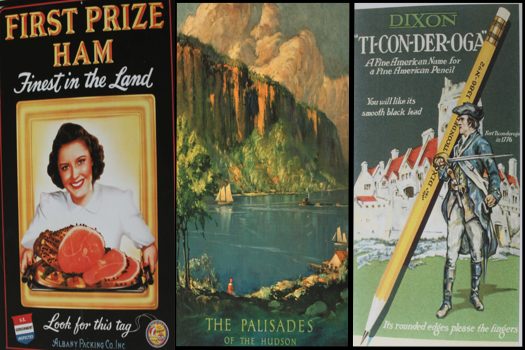
A few of the images from Graphic Design: Get the Message.
The Graphic Design: Get the Message exhibit at the Albany Institute of History and Art is definitely worth a visit for design nerds, it will also be interesting to anyone who's a critical consumer of media -- or just curious about the images we see every day.
Stay a little while and you'll see it's also about world history, innovation, how far we've come as a country, and how we absorb information...
... said KGB about Drawing: What's something that brought you joy this year?